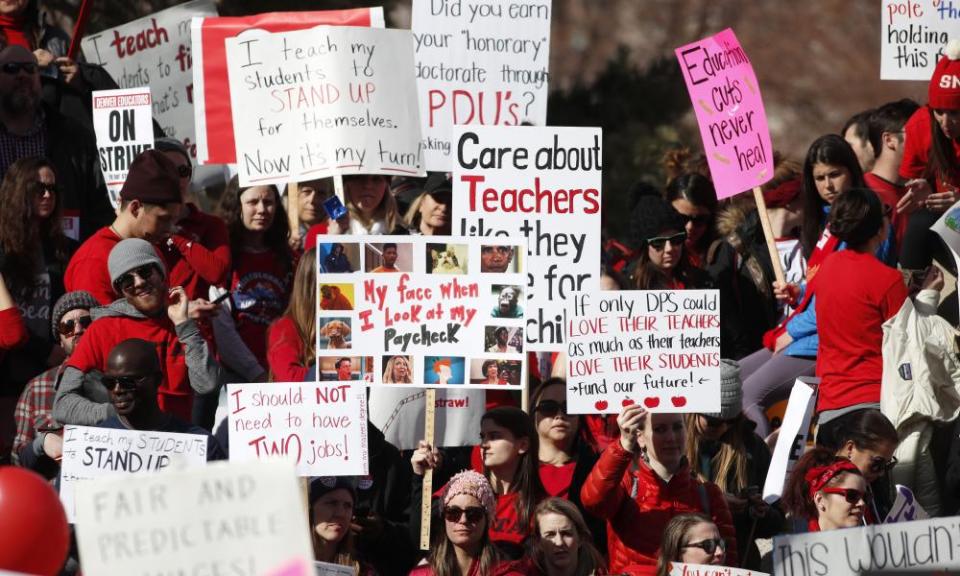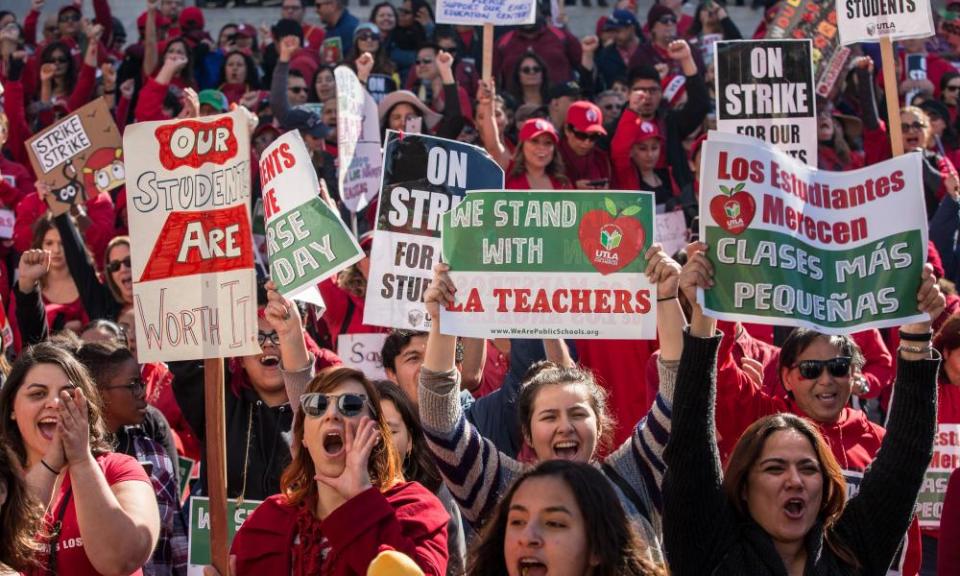Low pay, large classes, funding cuts: behind new wave of US teachers' strikes

Low pay, oversized classrooms, underfunding, old textbooks, a lack of support staff and high teacher turnover rates. These are a few of the reasons teachers across the United States cite as motivations behind a fresh wave of teacher strikes this year, restarting a phenomenon that provided a massive boost to the US labor movement in 2018.
So far in 2019 strikes have broken out in Los Angeles and Oakland in California, Denver in Colorado and in Virginia and West Virginia, notching up notable wins in terms of pay raises and better working conditions.
The fresh push on strikes has come despite a June 2018 supreme court ruling in the Janus case that held non-union members in the public sector do not have to pay union fees. The decision was seen as a serious blow to unions but teacher unions, at least, have avoided massive membership and funding losses and instead continued a nationwide burst of recruiting, organizing and successful strike actions.
For Tania Kappier, a history teacher at Oakland Technical high school and board member of a teachers union in Oakland , the motivations for taking action are simple and at the core of their job.
“Our work conditions are the student’s education conditions. We’re doing the best we can at an impossible job and that’s not okay for our students and it’s not okay for our own dignity,” Kappier said.
Kappier explained classrooms in Oakland’s school district are too large, her history textbooks are outdated, schools in the district don’t have nurses, adequate staffing of counselors, no librarians, and music and art programs are non-existent at some schools in the district. She also noted teachers in Oakland are not paid enough to make ends meet in a district where rental costs have soared 51.1% between 2012 to 2017.

The issues facing public schools in Oakland are similar to other school districts across America where teachers led a 30-year high in strikes in 2018. A common theme of these walkouts is drastic declines in public funding schools, where many states have not replenished cuts made to public education during the 2008 economic recession.
“After the last recession, nearly every state cut their school funding, in many cases cut very deeply,” said Michael Leachman, senior director of State Fiscal Research at the Center on Budget and Policy Priorities.
Leachman co-authored a November 2017 report that found 29 states were funding less per student in 2015 than they were in 2008. States with high declines in state funding have been sites for some of the largest teacher strikes.
“As the economy gradually improved coming out of the recession, some states made the challenge more difficult by deeply cutting income taxes which is the primary revenue source for states,” said Leachman. “They essentially locked in their recession era cuts for school funding.”
In all, statewide teacher strikes occurred during 2018 and 2019 in West Virginia, California, Colorado, Virginia, Arizona, Oklahoma, Kentucky, and North Carolina. Many of these states are leaders in the teacher pay gap, the percentage gap by which public school teachers are paid less than comparable workers. This gap hit a record high in 2017 at 18.7%.
“Systemic defunding of public schools, amid tax cuts for the wealthiest and profiteering efforts, has left teachers to lead the fight for one of our highest ideals, the promise to educate each and every kid regardless of means,” said Dr Sylvia Allegretto, co-chair of the Center on Wage and Employment Dynamics at UC Berkeley.
The wave of action began in February, 2018, when around 20,000 teachers in West Virginia shut down schools in every county in the state for nine consecutive days before the governor signed a bill giving teachers and other school staff a 5% raise to end the strike.

Last week, teachers in West Virginia went out on strike again for two days to protest a bill being pushed in the state senate that would tie teacher pay raises to funding for charter schools.
“The issue last year was mainly over benefits. This issue this year is the Republican state senate proposed this bill that was really vindictive toward teachers and had things in it that would hurt students,” said Jacob Fertig, an art teacher at Riverside high school in Belle, West Virginia.
He noted pay and benefits for teachers have been in decline throughout the state, and students are facing difficult living situations due to the opioid epidemic plaguing West Virginia.
“At the school I’m at, the students are lucky enough to have one parent. A lot of kids live with boyfriends, girlfriends, sisters, brothers, or whoever can take them in because parents are addicted to drugs,” Fertig said. “That translates to a classroom where kids don’t have a lot of prospects, they don’t have a lot of hope and it’s very difficult in terms of teaching them because a lot of their basic needs are not met.”
Around 31,000 teachers in Los Angeles started off 2019’s strike wave in the nation’s second largest school district, walking out for seven days before settling on an agreement that included a pay raise, increase of support staff, and a plan to reduce class sizes to mandated caps.
“The takeaway from these teacher strikes are politicians and administrators who think the teacher unions are weak, vulnerable, and can be broken have been proven wrong,” said Larry Strauss, a high school English teacher in Los Angeles.
“Whatever they offer after a few days after a strike, they could’ve offered before a strike,” added Strauss. “They could have offered that before they lost millions of dollars during a strike. So the only reason to allow a strike is to test the strength of the union. That’s clearly what they’re doing, and teacher unions so far have stood up to the test.”

 Yahoo News
Yahoo News 
